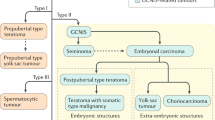Abstract
Though testicular cancer (TC) is the most common malignancy in 15–35-year-old men [1], it accounts for only 1–2 % of all neoplasms in men [2]. Worldwide, the incidence of TC has doubled in 40 years [3]. Risk factors for TC include cryptorchidism, a personal or family history of TC, and intratubular germ cell neoplasia. Over 95 % of testicular cancers are germ cell tumors, including seminomas and nonseminomatous tumors; non-germ cell tumors, including Leydig and Sertoli cell tumors, account for <5 % of all testicular cancers [4]. Men generally present with localized disease (69 %). Five-year relative survival, inclusive of all stages, is 95.3 % [5].
Access this chapter
Tax calculation will be finalised at checkout
Purchases are for personal use only
Similar content being viewed by others
References
Masterson TA, Beck SDW. Testicular cancer: clinical signs and symptoms. In: Scardino PT, Linehan WM, Zelefsky MJ, Vogelzang NJ, editors. Comprehensive textbook of genitourinary oncology. Philadelphia: Wolters Kluwer; 2011. p. 505–8.
Huyghe E, Matsuda T, Thonneau P. Increasing incidence of testicular cancer worldwide: a review. J Urol. 2003;170(1):5–11.
National Comprehensive Cancer Network. Testicular cancer (Version 1.2013). http://www.nccn.org/professionals/physician_gls/pdf/testicular.pdf. Accessed 15 Sept 2013.
Stephenson AJ, Gilligan TD. Neoplasms of the testis. In: Wein AJ, Kavoussi LR, Novick AC, Partin AW, Peters CA, editors. Campbell-Walsh urology. 10th ed. Philadelphia: Elsevier; 2011. p. 837–70.
National Cancer Institute SEER Stat Fact Sheets: Testis. http://seer.cancer.gov/statfacts/html/testis.html. Accessed 15 Sept 2013.
Moul JW. Timely diagnosis of testicular cancer. Urol Clin North Am. 2007;34(2):109–17.
Kaufman MR, Chang SS. Short and long-term complications of therapy for testicular cancer. Urol Clin North Am. 2007;34(2):259–68.
Tarin TV, Sonn G, Shinghal R. Estimating the risk of cancer associated with imaging related radiation during surveillance for stage I testicular cancer using computed tomography. J Urol. 2009;181(2):627–33.
Reuter VE. Anatomy and pathology of testis cancer. In: Scardino PT, Linehan WM, Zelefsky MJ, Vogelzang NJ, editors. Comprehensive textbook of genitourinary oncology. 4th ed. Philadelphia: Wolters Kluwer; 2011. p. 531–41.
Carver BS, Feldman DR. Staging of testicular cancer. In: Scardino PT, Linehan WM, Zelefsky MJ, Vogelzang NJ, editors. Comprehensive textbook of genitourinary oncology. 4th ed. Philadelphia: Wolters Kluwer; 2011. p. 544–7.
Author information
Authors and Affiliations
Editor information
Editors and Affiliations
Rights and permissions
Copyright information
© 2014 Springer-Verlag Berlin Heidelberg
About this chapter
Cite this chapter
McGinley, K.F., Rampersaud, E.N. (2014). Testicular Cancer. In: Merseburger, A., Kuczyk, M., Moul, J. (eds) Urology at a Glance. Springer, Berlin, Heidelberg. https://doi.org/10.1007/978-3-642-54859-8_57
Download citation
DOI: https://doi.org/10.1007/978-3-642-54859-8_57
Published:
Publisher Name: Springer, Berlin, Heidelberg
Print ISBN: 978-3-642-54858-1
Online ISBN: 978-3-642-54859-8
eBook Packages: MedicineMedicine (R0)




